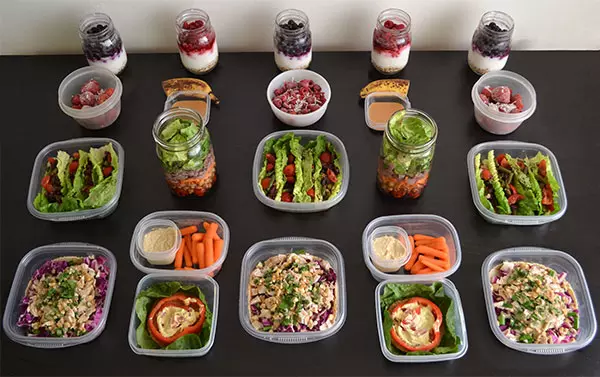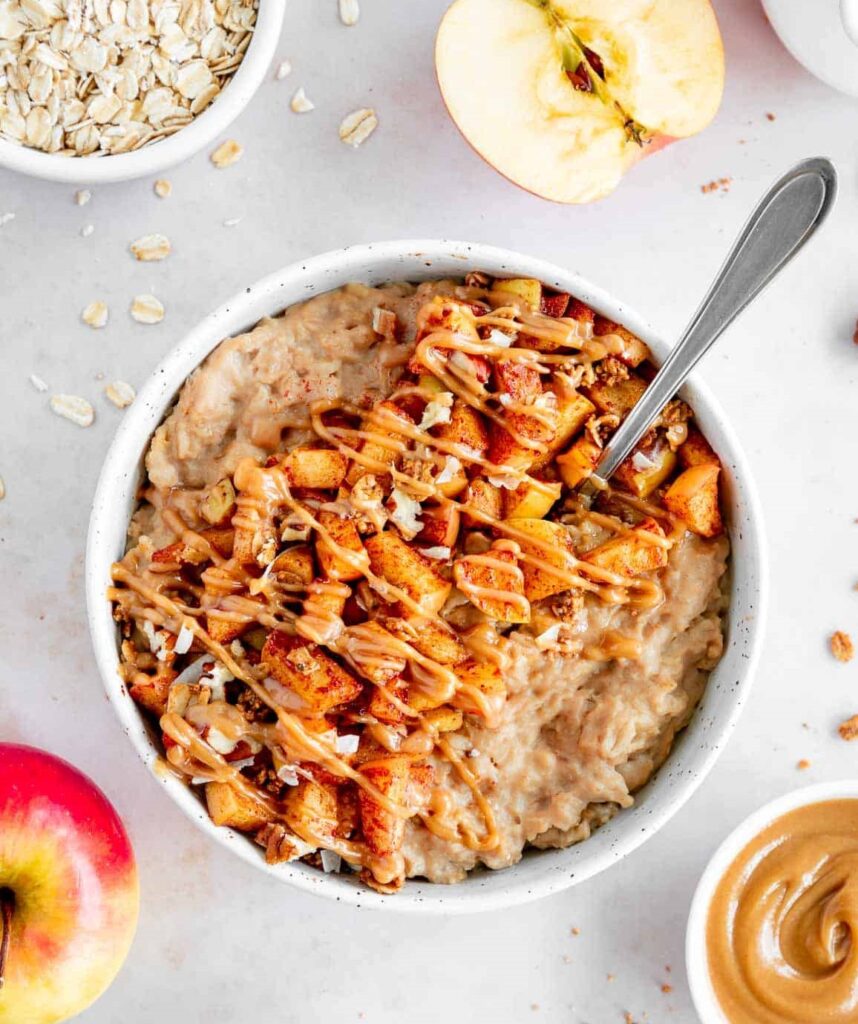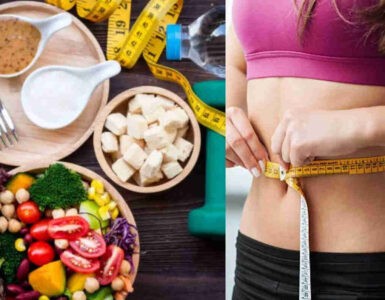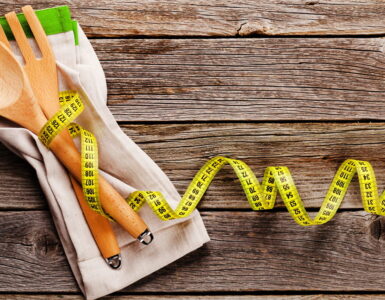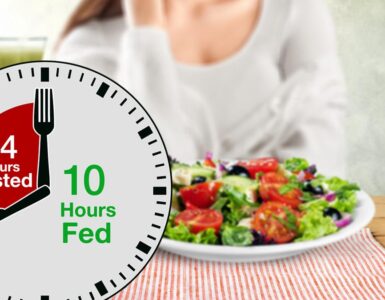Apples for breakfast, carrots for lunches, cucumbers and brussels sprouts for dinners, water and tea in between the ‘meals’ – that’s quite an accurate description of a typical weight loss menu when we know nothing about the nutritional value of foods. However, eating in a calorie deficit will enrich your meal plan with diverse meals and help you lose weight and become healthier. A calorie deficit meal plan is simple because it’s made of ordinary and affordable products for everyone. Different combinations of ingredients will make the meal filling, nutritious and delicious, so a healthy diet will never demotivate you.
How to choose the products for a calorie deficit diet plan for weight loss? How to define if you need a calorie deficit plan? Let’s answer these questions together and make a perfect breakfast-lunch-dinner menu that fits your taste and shape.
Page Contents
What Is A Calorie?
‘Calories’ in our images look like tiny evil creatures that cause significant weight gain. The tastier the food is, the more calories you consume, and the more fat comes. Therefore, if you want to start a diet, you need to eat tasteless food: the less, the better.
However, everything works differently. Calories provide us with energy for everything, basically to maintain our aliveness.
There are two units to measure energy – kilojoules (kJ) and calories (kcal) [1].
A kilocalorie is the amount of heat needed to raise the temperature of 1 kilogram of water one degree Celsius. The “calorie” we typically refer to in food is, actually, kilocalorie.
Kilojoules are the metric measurement of calories. The conversions are as follows:
- 1 kJ = 0.2 Cal
- 1 Cal = 4.2 kJ
Different products have different calories load – you can always check this information on the food label. You can use the calorie information to estimate how different types of products fit into your daily calorie intake.
How Does This Affect My Weight Loss?
First of all, let’s do away with some common weight loss misconceptions.
- By eating healthy food, you are saved from weight gain.
This statement contradicts reality. Even having a healthy meal plan, you’ll gain weight if you overeat and don’t burn all the energy taken in. You can maintain your weight by having calories in-out equal. It’s not a matter of one day. If you had too much one day, you could lower the food intake the following day.
- Healthy food is more expensive.
Well, it’s not as simple as that. Making a vegetable soup or pasta with cheese and tomatoes – healthy options, however, don’t cost a fortune.
- Starving must follow a feast day to even the number of calories.
First of all, starving is a big “NO.” It’s stressful and doesn’t make any sense. When your body experiences such diets, you’ll subconsciously eat more the following days. As long as your primary function is to survive, your body will use this option and store as much energy as it can when there’s a possibility.
It’s better to be moderate while eating. Luckily, you live in a world with no food shortage. You can easily eat the food you want next time.
- Skipping meals is beneficial for the daily calorie deficit.
It may occasionally happen because you’re overloaded with work or routine. However, the experience begs to differ. When you skip meals during the day, in the evening, you have an illusion of a huge calorie and energy gap; therefore, you start eating more – catching up on everything that was skipped and even more.
As already mentioned, if you want to maintain the same weight, the calories-in must equal calories-out.
If you want to gain weight and muscle mass, it is better to enrich your menu with healthy proteins and complex carbs and do regular physical activities. Be attentive. Gaining muscle mass doesn’t mean devouring everything you see in the fridge. It’s about increasing a healthy portion of nutrients and working out for a toned body.
If you need to lose weight, you need to lower your calorie intake (not eliminate food) and do more physical exercises.
How Do I Know My Ideal Calorie Deficit?
Before defining how many calories you need to cut, it’s essential to understand if you really need to lose weight. First, check your body mass index (BMI) following the formula, or use the online calculator.
BMI = kg/m2
Suppose your body mass is within a healthy limit – there is no need to diet, just a regular workout to tweak and shape your body. If it got into the orange zones, it’s high time you started a weight loss period.
Weight loss can be provided by the negative calorie balance – less in-more out. Lowering the caloric intake, you still need to cover your protein, fats, and carbs needs. Typically, you will cut down on every hour snack, or extra piece of pie, or stop feeding your emotional hunger.
To create a calorie deficit, you must increase your total daily energy expenditure. A rule of thumb for healthy weight loss is about 500 calorie deficit per day [2]. Where do these numbers come from?
Aim for 1 to 2 pounds (0.5 to 1 kilogram) a week for healthy and sustainable weight loss.
1 pound equals 3500 calories. Therefore, a 500-1000 calorie deficit every day will make you reach your goals. [3].
You will be interested in the article — How to burn 1000 calories?
Some people can create a 500-1000 calorie deficit by shortening their food lists only. However, exercising is the key to a stronger and healthier body. Aim for 30+ minutes on most days of the week, slowly increasing the time and adjusting to your working schedule. Weight loss doesn’t tolerate hasty decisions and rush. That’s why hitting the gym every day isn’t an option. Start with effective yet moderate cardiovascular exercises like walking 1-3 miles or jogging. It will help to make movement a part of your daily routine.
Entering weight loss slowly will bring more health benefits than diving into it unprepared. Extra stress will just cause overeating again.
!!! Don’t make the calorie deficit lower than 1200 calories. It may lead to health issues, slower metabolism, fatigue, and energy deficit.
What Are Calorie Deficit Meals?
Calorie deficit meals, as the name suggests, are created to fit every weight loss meal plan. Despite their ‘smart’ names, these dishes are pretty simple, however, nutritious and energizing. Despite being made from different ingredients, they share the same features:
- Cooking time is up to 60 minutes with all preparation and serving.
The meals that take longer to prepare typically have a lower value vitamin-wise. When sticking to a healthy diet, avoid or limit highly-processed food.
- The shorter the ingredients list, the better for your health it is.
That’s probably the best side of healthy nutrition – all the ingredients are easy to find and affordable. Besides, you will have a chance to feel the taste of every ingredient and enjoy it. When you have a miscellaneous of everything, you lose the basic savor.
- Healthy dishes are nutritious and tasty.
Despite a common claim that a healthy menu is dull, plain, and flavorless, it’s tasty and filling. Instead of eating a package of French fries with a burger, try a salad with salmon, feta, and tomatoes. With the exact weight of the dish, the calorie and benefit load will be different. On the one side, with French fries and a burger, we’ll have a filling and tasty lunch but lack of nutrients. On the other side, the salad – a flavourful and filling lunch, will provide you with energy, vitamins, and significantly fewer calories, which is a keystone to weight loss.
- Lower caloric load
People typically think that a healthy diet meal plan includes vegetables and water only and does not exceed 500 calories per day. However, it’s a far cry from reality. You can get a full set of proteins, healthy fats, and complex carbs just by mixing simple yet nutritious ingredients. They will keep you full during the day; however, they will maintain your weight loss. Besides, lowering your daily meal plans to only 500 calories will bring you nothing but health loss.
Calorie Deficit Breakfast Meals
Breakfast is our energizer. It provides energy for the ongoing day, so skipping it is always a bad idea. According to research, missing the first meal of the day leads to obesity in the long run [4].
-
Spiced Apple Oats With Honey
Oatmeal is a superhero among cereals, an excellent source of fiber, part and parcel of a healthy diet meal plan. A bowl of stewed apples, oats, and nuts will make a perfect breakfast and a start to a day. Despite being sweet, it will bring nothing but benefits.
Ingredients:
- 1 apple cored and chopped
- 2 tablespoons of honey
- 1/2 teaspoon of cinnamon (if you are okay with it)
- 3 spoons of water
- 1/4 teaspoon of salt
- 1 cup of rolled oats
- 2 cups of water
- 1/4 of chopped mix of nuts for serving
Directions:
- In a saucepan, heat apple, cinnamon, and 3 tablespoons of water over medium – high until simmering. Cook until apples are tender, about 5 minutes. Save 1/2 cup of apple mixture for garnish.
- Add oatmeal and 2 cups of water to a saucepan. Stir occasionally until oats are creamy, about 5 minutes.
- Serve with a spoon of honey, apple, and nuts mixture. Nuts can be substituted with a scoop of peanut butter.
-
Baked Egg Muffins With Spinach
Baked spinach egg muffins are quick and simple and make a perfect grab-and-go for busy mornings. They are low calorie meals, low in carbs, keto-friendly, and packed with protein. This dish is an ideal fit for low calorie meal plan.
We advise you to read — No carbs no sugar diet plan for 2 weeks.
Ingredients:
- 10 large eggs
- 1 – 1 1/2 teaspoons of salt
- 1/4 – 1/2 teaspoon of black ground pepper
- 1/2 teaspoon garlic powder
- 1/2 teaspoon dried basil
- 2 cups chopped spinach
- 1 1/2 cups grated cheddar cheese (and some cheese for topping)
Instructions:
- Preheat the oven to 400 F.
- In a large measuring cup or mixing bowl, crack in all the eggs and whisk together with salt and black pepper. You can whisk egg whites first and then add the yolks. It will improve the texture of the muffin.
- Mix in garlic powder and basil until homogeneous. Stir in spinach and cheese.
- Divide into muffin cups filling each about 2/3 full. You will have 10-12 muffins.
- Bake in preheated oven for 12-15 minutes, or until set.
- Sprinkle baked muffins with more cheese when serving them.
-
Garden Vegetable Frittata
Basically, a frittata is an egg-based pie. You can put almost anything in a frittata: cheeses, meats, and vegetables – anything you may have on hand! It will make a perfect breakfast as well as lunches and dinner. Besides, it’s rich in protein.
Ingredients:
- 1 small red bell pepper – cored and chopped
- 1 small zucchini small – diced
- 4 ounces broccoli cut into small florets
- Salt and black pepper (to taste)
- 2 tablespoons of olive oil (go for virgin olive oil)
- 7 eggs
- ¼ teaspoon of garlic powder
- ¼ cup whole milk
- ⅓ cup feta cheese – crumbled (for serving)
Instructions:
- Whisk together the frittata base: eggs, milk (any type), garlic, salt, and pepper.
- Sauté on medium heat your veggies in a 10 or 12-inch skillet until tender.
- When the veggies are soft, stir in any spices or herbs before adding the eggs.
- Pour in the frittata base, and distribute it among the vegetables.
- Sprinkle your frittata with cheese and put the pan in a 400-degree oven.
- Bake for 15 to 20 minutes (until the top is lightly golden around the edges).
- Allow the frittata to cool before slicing.
The zucchini, broccoli, and pepper can be replaced with the vegetables you prefer.
Calorie Deficit Lunch Recipes
Lunch is typically taken while being at work or studying. It’s essential to have a high in nutrient meal to help you work efficiently. Instead of a peanut butter lunch (sandwiches or cookies), give preference to veggies.
-
Vegetable Soup
Vegetable soup is healthy, filling, and energizing. It makes you warm in cold times and helps to cool down in summer. This meal is light on calories but high on nutrients, as long as it contains low-calorie foods.
Ingredients:
- 2 Tbsp olive oil
- 1/2 cup of chopped yellow onion
- 1 cup carrots – peeled and chopped
- 1 cup of celery – chopped
- 1-4 cloves of garlic – minced
- 3 cans of chicken or vegetable broth
- 1 can of tomatoes diced
- 2 cups potato – peeled and thick diced (from about 3 medium)
- 1 cup of green beans – chopped frozen or fresh
Instructions:
- Heat olive oil in a large pot over medium-high heat.
- Add onions and carrots and saute for 5-7 minutes.
- Add in broth, tomatoes, potatoes, and season with salt and pepper to taste.
- When the broth boils, add green beans.
- Reduce heat to medium-low, cover with a lid and simmer until potatoes are ready – almost entirely tender 20-30.
The vegetables for ingredients can be varied as you like. Their amount depends entirely on your taste.
-
Mushroom & Mint Salad
Ingredients:
- 1 tablespoon of olive oil
- 1garlic clove (if you eat it)
- 2 cups of mushrooms – chopped stems, sliced caps
- 25 g of mint – chopped
- fresh parsley, chopped
- salt & ground pepper, to taste
Instructions:
- Clean the mushrooms, slice the caps and chop the stems.
- Warm up the oil to medium heat, and add the garlic and mushrooms.
- Sauté briskly for 4 minutes – mushrooms are tender but crisp.
- Add chopped mint and parsley, and cook for one minute more.
- Add salt and pepper to taste.
Changing the portion of mushrooms, you can make it the main course or side dish.
-
Chicken Enchiladas
Chicken breast matches your protein needs and low calorie meal plan.
Ingredients:
- 1 cup of chicken – cooked and shredded
- 2 cups of enchilada sauce (or salsa, if preferred more)
- 6 corn or flour tortillas
- 2 1/2 cups of cheese – shredded
- salt and pepper (to taste)
- Optional: sliced onions, chopped cilantro, sour cream, shredded lettuce, cheddar.
Instructions:
- Preheat the oven to 350ºF. I
- In a large bowl, combine the shredded chicken, 1/4 cup enchilada sauce, salt, and pepper. Mix.
- When using corn tortillas: Wrap the tortillas in a damp paper towel and heat them in the microwave for 1 minute until all of them are warm and pliable.
- When using flour tortillas, heat them on a plate for 1 minute until all of them are warm and pliable.
- Assemble the enchiladas – fill each tortilla with a mixture of shredded chicken and cheese. Roll the tortillas tightly and place in a baking dish, seam-side down.
- Pour the remaining enchilada sauce over the tortillas, cover the top with the remaining cheese, and bake for 20 minutes (the cheese is melted and bubbly).
- Serve immediately.
Calorie Deficit Dinner Recipes
Dinner is, supposedly, the last meal of the day. It should be nutritious and filling but not have a ‘heavy’ effect. Instead of gulping up everything you see after a tiring day, take your time, and enjoy every bite and piece you eat. If you gulp everything, your brain will not get a signal that you actually had a meal. That’s why numerous snacks will follow the main meal.
-
Lemon Chicken Stir Fry
This meal takes less than 30 minutes to make, but it’s tasty and healthy. It can be served with rice and green beans, as an option.
Ingredients for Sauce:
- ¼ cup soy sauce
- ¼ cup honey
- 1 teaspoon lemon zest
- 3 tablespoons lemon juice
- 1 1 tablespoon grated ginger root
- 4 cloves of garlic – minced
Ingredients for The Chicken:
- 1 ½ pounds chicken breast – Cut into pieces
- 10 oz green beans – trimmed and cut in half
- salt, pepper, olive oil
- 1 cup cooked brown rice (as the main dish)
Instructions:
- Whisk together all ingredients for the sauce and set them aside.
- Toss the chicken with salt and pepper, and set aside.
- Heat a sauté pan, and add one tablespoon of oil. Cook the green beans for 3-4 minutes and remove from the pan.
- Add a spoonful of oil onto the pan again and add chicken. Cook it for 3-4 minutes per side until cooked.
- Add the green beans back to the pan with the chicken. Pour in the sauce.
- Stir and cook for 2-3 minutes until the sauce thickens, and the chicken and green beans are fully coated.
- Garnish with sesame seeds and serve with brown rice (if desired).
-
Citrus Chicken And Kale Salad
Ingredients:
- 1 ¼ pounds chicken breast – halved lengthwise
- 1 large bunch (10 oz.) flat kale
- 3 tablespoons tahini (sesame paste)
- Zest and juice of 1 lemon
- 1 tablespoon honey
- 1 garlic clove – minced
- 2 small firm apples – cored and chopped
- ¼ cup toasted almonds – chopped
- 4 Medjool dates, pitted and chopped (1/4 cup)
Instructions:
- Heat a grill to medium-high (about 450°).
- Brush chicken with 1 tbsp. oil and season with 1/2 tsp. each salt and pepper.
- Grill chicken until cooked through, 4 to 5 minutes total. Take on the plate.
- Grill kale until kale is softened, about 2 minutes.
- Whisk 2 spoons of oil in a large bowl with tahini, lemon zest, juice, honey, garlic, salt, and pepper.
- Chop the chicken, thinly slice kale and add both to the bowl of dressing. Add apples, almonds, and toss gently.
-
Mixed Bean Stew With Beetroots
Ingredients:
- 1 medium onion – thinly sliced
- 3 beets – grated
- 3 carrots -grated
- yellow bell pepper – cored and chopped
- 4 medium tomatoes – chopped
- 1 can of black beans – drained and rinsed
- 1 tsp garlic powder
- sea salt and pepper to taste
- 1/4 lemon
- 1 glass of water
Instructions:
- In a big pot, heat the 2 tbsp of olive oil over medium heat. Add the onion and cook for about 4 minutes, stirring occasionally. Add the beets, carrots, bell pepper, and tomatoes. Cover and cook until the vegetables soften – 5 to 7 minutes. Don’t forget to stir occasionally.
- Add water, black beans, and garlic powder. Season with salt and pepper to taste, and let it boil. Reduce the heat, cover, and cook for about 10 minutes.
- Squeeze the lemon juice into the stew. Cook the soup for another 2 to 5 minutes and turn off the heat.
- Serve with whole-grained croutons.
When creating a low-calorie diet to lose weight, be attentive to your chosen ingredients. Most recipes are variable, giving you leeway in planning: peanut butter, though stated in the recipe, can be easily changed with other nuts or dried fruits, and veggies can be different according to your needs. Also, consider all the possible allergies you may have.
Conclusion
What to eat on a calorie deficit diet?
Sticking to a healthy diet is not as difficult as it seems. Going to KFC or Mcdonald’s is undoubtedly faster; however, it’s not as diverse as homemade food. Eating healthy and nutritious dishes doesn’t require much money and time. Typically, a healthy meal plan includes affordable products and takes up to 1 hour, including preparation, serving, and eating.
Meals for calorie deficit provide you with just enough calories your body needs for functioning; however, they go easier on your digestive system and the total caloric number. When you combine calorie deficit meals with regular exercise, your results will show up faster because they complement each other.
Meal planning is essential, as it gives a balanced approach to nutrition and helps to maintain a healthy body. Moreover, it makes you organized and helps to stay on track. Plan your meals week by week, and see how your attitude towards food changes.
After you start cooking calorie deficit foods, you’ll understand they are not dull or super-expensive.
The other way round, the list of recipes is endless; surprisingly, they are typically quick. Brussels sprouts, when cooked correctly, can be mouthwatering and beneficial. Pancakes aren’t necessarily sweet and caloric; they may have less than 200 calories and high protein content.
As with all changes, making the first step toward your goal is the most important. It’s only your imagination that creates difficulties for dieting. Reality gives you all the options for your good; just use them.

